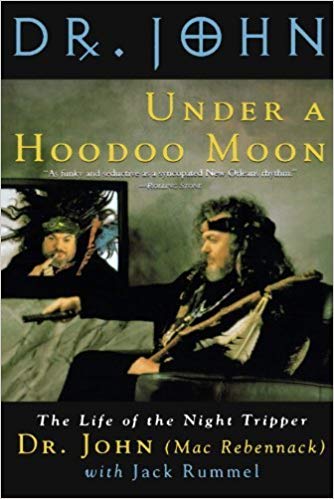
So many books, so little time.
Dr. John’s autobiography Under a Hoodoo Moon came out in 1994 (co-author Jack Rummel). Today it’s on Amazon for $45. And as my first read of the year 2020, I must return my New York Public Library copy TONIGHT because somebody else is waiting for it.
Malcolm John (Mac) Rebennack was born in 1941 and died last summer, a link in a chain of 20th century New Orleans pianists, shading his tunes with dance beats and lacy decoration. He led a life of magic and treachery, spiritualists, gris-gris, managers who cheat.
Toward the end of the book he shines a light on the pianists around him. James Booker seems almost a savant who “could play it all – stride piano, butterfly, boogie, all the other New Orleans styles, the Chicago styles, the Memphis styles, the Texas styles, the California styles, bebop, avant-garde jazz, classical, even pop!” I love this list.
Booker’s bandmates edited their own solos because if they played too long, “Booker would come out with a solo that would just blow them off the stage and disgrace them.” One night in Chicago at the Aragon Ballroom, Booker didn’t even come to the bandstand. Instead “this big mountain of sound began to swell beneath us . . . . It was just roaring; the whole stage was moving.” Booker had discovered the pipe organ in the orchestra pit. The instrument was massive but Booker “sat down and cranked it up like it was nothing.”
The self-taught and providential Professor Longhair (“Before him was the void; after him, we’re just whistling in the dark”) became Dr. John’s second father. Fess gets his own chapter with vignettes about him at home in his easy chair, wired to control scents, lights and music (pre Alexa and Siri) and even deliver a keyboard to his lap. There’s Fess in the recording studio dictating his individual part to each player, and Fess mentally orchestrating his music for banjos, tubas and trombone (never recorded but should have been). And Fess in the parlors and clubs, negotiating New Orleans’s rigid hidden castes, his playing both graceful and seriously rocking, in shirtsleeves or a tux, a cap or a turban. I can almost see and hear it.
For others who long for more time with the late Dr. John, read Under a Hoodoo Moon: The Life of the Night Tripper from St. Martin’s Press.

